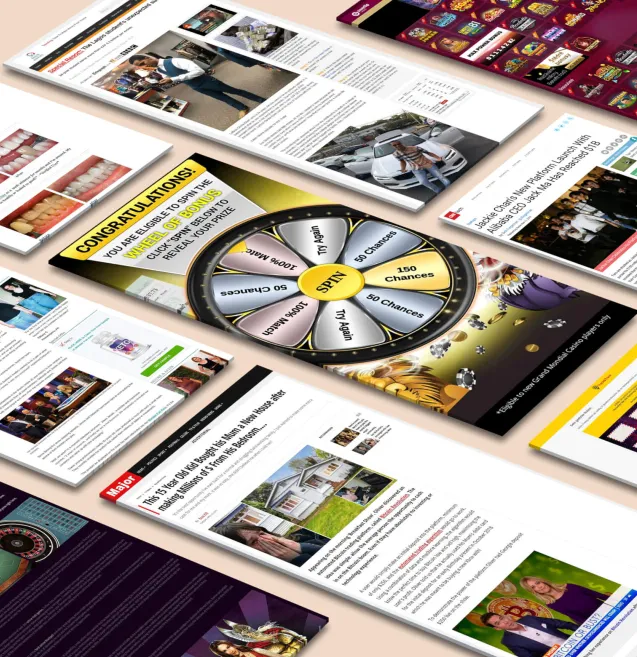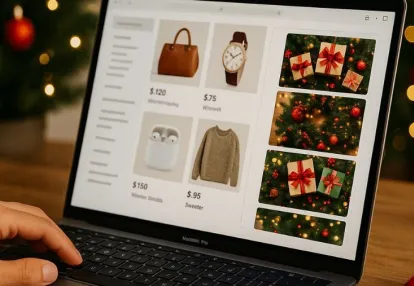
Наши инструменты отслеживают миллионы рекламных кампаний в форматах native, push, pop и TikTok.
НачатьРеклама в нескольких каналах — это стратегический подход, который вовлекает клиентов через несколько предпочтительных каналов с персонализированным и бесшовным опытом. В отличие от традиционного мультимаркетинга, функционирующего в изолированных каналах, реклама в нескольких каналах создает целостные пути взаимодействия клиентов с помощью интегрированных стратегий и единого месседжа.
В условиях современного конкурентного цифрового ландшафта, интеграция нативной рекламы и пуш-уведомлений стала ключевой для максимизации ROI. Нативная реклама органично вписывается в контент платформы, обеспечивая более высокую вовлеченность, а пуш-уведомления доставляют вовремя и персонализированные сообщения непосредственно на устройства пользователей. При стратегичном совместном использовании эти каналы создают мощные точки взаимодействия, ведущие клиентов от осведомленности к конверсии.
Современные потребители ожидают последовательный опыт на всех цифровых точках контакта. Вам нужна стратегия нативной и пуш-рекламы, которая гармонично работает с другими каналами, такими как электронная почта, SMS и веб, чтобы привлекать внимание и побуждать к значимым действиям. Сочетание деликатного подхода нативной рекламы и прямого общения пуш-уведомлений создает возможности для длительной вовлеченности и повторяющихся конверсий.
В этой статье представлены 10 блестящих советов, которые помогут вам эффективно использовать нативную рекламу и пуш-уведомления в рамках рекламных кампаний в нескольких каналах, трансформируя способ взаимодействия с аудиторией и обеспечивая измеримые результаты.
Кросс-канальный маркетинг — это значительное изменение по сравнению с традиционными многоканальными подходами. Тогда как многоканальный маркетинг использует разные каналы отдельно — каждый со своей стратегией, коммуникацией и целями — кросс-канальный маркетинг формирует единый опыт, объединяющий все точки взаимодействия на пути клиента.
Ключевое различие заключается в интеграции против фрагментации. Многоканальный подход рассматривает каждую платформу как отдельный объект, в результате чего сообщения становятся несогласованными, а пользовательский опыт — разрозненным. Напротив, кросс-канальный маркетинг объединяет все каналы для совместной работы, обмениваясь данными и аналитикой, чтобы создавать цельные истории, сопровождающие клиентов повсюду, где они взаимодействуют с вашим брендом.
Бесшовные и персонализированные пути клиента имеют решающее значение для успеха кросс-канальной рекламы. Недостаточно просто охватить клиентов на нескольких платформах; вы также должны создавать взаимосвязанные впечатления, которые запоминают предыдущие взаимодействия и соответствующим образом адаптируют сообщения. Например, когда клиент оставляет товары в корзине на вашем сайте, ваша кросс-канальная стратегия может спровоцировать персонализированное push-уведомление в течение нескольких часов, затем целевое письмо на следующий день и ретаргетинговые объявления в социальных сетях — все с единым стилем коммуникации и предложениями.
Мобильные каналы играют важнейшую роль в современных интегрированных маркетинговых стратегиях. Push-уведомления, SMS, электронная почта, мобильные приложения и веб-платформы открывают множество возможностей для взаимодействия с клиентами в течение их повседневной активности. Эти каналы отлично подходят для своевременной доставки релевантных сообщений, побуждающих к немедленным действиям, а также для развития долгосрочных отношений за счёт постоянных полезных взаимодействий, учитывающих предпочтения и поведение пользователей.
Родной рекламная стратегия процветает в рамках интегрированных кампаний, потому что она легко сочетается с окружающим контентом, становясь менее навязчивой и более привлекательной для пользователей. Ключевые элементы успеха включают контекстную релевантность, форматирование, специфичное для платформы и ценностно ориентированный контент, который соответствует естественному пользовательскому опыту просмотра.
Когда вы комбинируете родную рекламу с другими каналами, вы создаете согласованность, которая повышает эффективность рекламы во всей экосистеме кампании. Родная реклама работает особенно хорошо в сочетании со:
Такой интегрированный подход усиливает персонализированное сообщение за счёт поддержания единого стиля бренда и визуальной согласованности на всех точках контакта. Пользователи проходят согласованный путь, а не сталкиваются с разрозненными рекламными вставками.
Примеры из реальной жизни демонстрируют эффективность родной рекламы на разных платформах:
Такие согласованные усилия приводят к более высокому уровню вовлечённости и улучшению конверсии по сравнению с отдельными кампаниями родной рекламы.
Веб-уведомления служат прямым каналом связи между вашим брендом и пользователями, обеспечивая мгновенную доставку сообщений, которые пробиваются сквозь цифровой шум. Ваша стратегия веб-уведомлений становится гораздо эффективнее, когда она интегрируется с нативной рекламой в рамках кампаний Кроссплатформенная реклама: натив + веб-уведомления для максимальной отдачи от инвестиций.
Ключевые метрики вовлечённости определяют успех ваших веб-уведомлений:
Эти метрики дают практические данные для оптимизации кроссплатформенной эффективности и выявления сообщений, которые находят отклик у разных сегментов аудитории.
Время превращает обычные веб-уведомления в катализаторы конверсии. Вам нужно отправлять сообщения в моменты максимальной восприимчивости пользователей — например, напоминания о заброшенной корзине в течение 30 минут или оповещения о распродажах в часы пиковой активности. Персонализация усиливает этот эффект за счёт использования имён пользователей, истории покупок или специальных предложений, привязанных к местоположению.
Динамический сегментирование поднимает вашу стратегию веб-уведомлений на новый уровень, автоматически группируя пользователей на основе их поведения в реальном времени, предпочтений и паттернов вовлечённости. Это позволяет одновременно предлагать уведомления о премиальных товарах высоколояльным клиентам и отправлять напоминания неактивным пользователям, чтобы вернуть их обратно.
Чёткие кнопки призыва к действию стимулируют немедленные реакции. Вместо расплывчатых фраз вроде «взгляните на это» используйте конкретные CTA, такие как «купить со скидкой 50% сейчас» или «завершите свой заказ», чтобы создать ощущение срочности и направить действия пользователей.
Чтобы действительно стать лидером в рекламе через веб-уведомления, стоит воспользоваться инструментами, позволяющими находить прибыльные объявления. Анализируя самых успешных рекламодателей и маркетологов в этой области, вы сможете значительно усилить свою стратегию и максимизировать свою прибыль.
Вам нужен единый источник достоверной информации о клиентах, чтобы создавать значимые кросс-канальные впечатления. Когда вы объединяете данные первой стороны из взаимодействий с рекламой, вовлеченности в пуш-уведомления и других точек контакта, вы создаете всесторонние профили клиентов, которые способствуют росту конверсии.
Платформы объединенных данных позволяют отслеживать поведение пользователей по всем каналам и передавать согласованные сообщения. Например, если клиент нажимает на вашу нативную рекламу о кроссовках, но не совершает покупку, вы можете отправить персонализированное пуш-уведомление со скидкой на эти самые кроссовки на ограниченный период. Такой уровень персонализации повышает рентабельность инвестиций за счёт доставки релевантного контента в нужный момент.
Координация сообщений в реальном времени становится возможной, когда ваши данные беспрепятственно передаются между каналами. Вы можете избежать утомления от сообщений, убедившись, что клиенты не получают одновременно одинаковые предложения как в нативной рекламе, так и в пуш-уведомлениях.
Автоматизация с помощью ИИ преобразует то, как вы управляете сложными многоканальными кампаниями, анализируя паттерны поведения пользователей и автоматически запуская соответствующие сообщения. Алгоритмы машинного обучения анализируют тысячи точек данных, чтобы определить оптимальные время, канал и контент для каждого взаимодействия с клиентом.
Умная организация путей покупателя означает, что вам не придется вручную координировать, когда показывать нативные объявления, а когда отправлять push-уведомления. ИИ выявляет поведенческие триггеры, например, покидку корзины или паттерны просмотра товаров, и автоматически отправляет наиболее эффективное сообщение через наиболее результативный для конкретного пользователя канал.
Вы выгрываете благодаря возможностям ИИ:
Этот автоматизированный подход гарантирует эффективное ведение кампаний, позволяя вам сконцентрироваться на стратегии и создании контента.
Динамическая сегментация преобразует способ предоставления персонализированного опыта, автоматически корректируя группы аудитории на основе поведенческих паттернов в режиме реального времени. В отличие от статичных сегментов, которые остаются неизменными, динамическая сегментация постоянно меняется по мере взаимодействия пользователей с вашим брендом на различных точках контакта.
Ваше таргетирование аудитории становится значительно точнее, когда вы применяете методы сегментации одновременно к нативной рекламе и пуш-уведомлениям. Например, пользователи, которые оставили свои корзины без покупки, получают целевые нативные объявления с похожими товарами, одновременно получая пуш-уведомления с персонализированными промо-кодами.
Ключевое значение заключается в использовании данных первой и нулевой стороны для создания поведенческих триггеров, срабатывающих на всех каналах:
Такой единый подход к Рекламе в нескольких каналах: нативная + пуш для максимальной отдачи гарантирует, что ваши сообщения останутся актуальными и своевременными, независимо от того, где пользователи сталкиваются с вашим брендом.
Время выхода играет решающую роль между сообщением, которое приводит к конверсии, и тем, которое игнорируется. Ваши мультиканальные кампании должны доставлять персонализированные сообщения точно в тот момент, когда пользователи наиболее склонны к действию.
Координация сообщений в реальном времени, обеспечиваемая AI-автоматизацией, гарантирует, что ваши нативные объявления и push-уведомления достигают пользователей в тот момент, когда они наиболее вовлечены. Вы можете мгновенно отправлять push-уведомления после того, как пользователи оставили свою корзину, одновременно показывая им дополняющие нативные объявления в следующей сессии просмотра.
Оптимизация призывов к действию становится особенно важной при координации сообщений на разных каналах. Ваше push-уведомление может содержать прямой призыв «Завершить покупку», а нативная реклама при этом использовать более мягкий подход — «Узнать больше» — в рамках того же пользовательского пути.
Рассмотрите следующие стратегии персонализированных сообщений:
Вы добьетесь более высокой конверсии, если ваши сообщения будут восприниматься как персональные, а не массовые. Пользователи реагируют на сообщения, которые учитывают их конкретные интересы, привычки покупок и историю взаимодействия на ваших каналах.
Решения по обогащению данных превращают базовые профили клиентов в настоящие источники ценной информации для таргетинга. Вы дополняете профили клиентов дополнительными данными из взаимодействий в социальных сетях, истории покупок, поведения при просмотре контента и демографической информации, формируя детальные сегменты аудитории, что способствует росту конверсии.
Данные первого и нулевого уровня составляют основу вашей стратегии таргетинга. Когда вы собираете прямые отзывы с помощью опросов, центров предпочтений и отслеживания поведения, вы создаете подлинные профили клиентов, которые обеспечивают точный запуск рекламных объявлений и кампаний push-уведомлений.
Автоматизация на основе ИИ обрабатывает эти обогащенные данные в режиме реального времени, выявляя закономерности и триггеры, которые могут быть упущены при ручном анализе. Ваши кампании автоматически корректируют параметры таргетинга на основе:
Координация сообщений в реальном времени обеспечивает немедленное применение ваших обогащённых данных. Вы доставляете персонализированную нативную рекламу пользователям, демонстрирующим намерение купить, одновременно отправляя релевантные push-уведомления в зависимости от текущего этапа их пути, максимизируя релевантность рекламы и потенциальную отдачу от инвестиций на каждом соприкосновении.
Ограниченность ресурсов часто становится ключевым барьером при масштабировании Крейтивная реклама между каналами: Нетивная + Push для максимального ROI. Вам нужны свежие креативные объекты для нетивной рекламы, убедительные тексты уведомлений, а также персонализированные вариации контента, сохраняя при этом единство во всех каналах.
Инструменты без кода радикально увеличивают масштабы создания контента, устранив технические барьеры. Платформы вроде Canva, шаблоны Figma и конструкторы кампаний с перетаскиванием элементов позволяют вашей маркетинговой команде создавать профессиональные материалы без привлечения разработчиков. Вы сможете создавать множество вариаций нетивной рекламы, разрабатывать шаблоны уведомлений и создавать льндинги за минуты, а не недели.
Основной эффект возникает при сочетании инструментов без кода с объединёнными данными о пользователях. Вы сможете быстро генерировать персонализированные вариации контента на основе сегментов аудитории, поведенческих триггеров и требований к координации сообщений в режиме реального времени. Вместо одного типового объявления в нетивной рекламе вы создаёте десятки или сотни адаптированных, вариатов, прямо обращенных к разным потребительским профилям.
Этот подход ускоряет проведение тестов. Вы сможете запустить A/B-тестирование на нетивное и push-каналах одновременно, перебирая творческие элементы на основе данных о результатах без ожидания дизайн-ресурсов.
A/B-тестирование превращает ваши кросс-канальные кампании из предположений в истории успеха, основанные на данных. Вам нужны системные рамки тестирования, которые оценивают одновременно вариации нативной рекламы и стратегии push-уведомлений на всех этапах пути клиента.
Центры экспериментов централизуют ваши усилия по тестированию, позволяя вам:
Координация сообщений в реальном времени с помощью автоматизации на основе ИИ обеспечивает согласованность ваших тестов на всех каналах. Когда вы обнаружите, что персонализированные рекомендации товаров в нативной рекламе увеличивают CTR на 40%, вы можете мгновенно применить аналогичную персонализацию к своим push-уведомлениям.
Ваш центр экспериментов должен отслеживать единые метрики по всем каналам, а не изолированные показатели эффективности. Такой подход показывает, как показ нативной рекламы влияет на уровень вовлеченности push-уведомлений, создавая совокупный эффект, который максимизирует общий ROI кампании за счет циклов непрерывной оптимизации.
Устранение разобщённости каналов имеет решающее значение при запуске сложных кросс-канальных кампаний. В традиционных маркетинговых системах ваши нативные объявления, push-уведомления, email- и SMS-кампании часто находятся в отдельных системах, которые не могут эффективно взаимодействовать.
Интегрированные платформы решают эту проблему, создавая единую экосистему, в которой ваши кампании работают согласованно. Объединяя данные по всем каналам, вы значительно повышаете точность таргетинга, получая доступ к полным профилям клиентов вместо фрагментированной информации.
Автоматизация на основе ИИ в этих платформах обеспечивает координацию сообщений в режиме реального времени по всему маркетинговому стеку. Например, вы можете запускать цепочку нативных объявлений на основе вовлечённости в push-уведомления или автоматически отправлять персонализированные email-кампании после push-уведомлений об оставленной корзине.
Когда данные первого и нулевого уровня объединяются по всем каналам, они становятся значительно мощнее. Предпочтения, поведение и прямые отзывы ваших клиентов влияют на каждый сценарий взаимодействия — от выбора креативов нативных объявлений до момента и персонализации push-уведомлений.
Результат? Вы доставляете согласованные, персонализированные сообщения, которые находят отклик у аудитории, одновременно максимизируя эффективность кампаний и возврат инвестиций за счёт синхронизированного выполнения.
Соблюдение требований в области конфиденциальности данных играет важнейшую роль в успешных крейсченных рекламных кампаниях. При сборе пользовательских данных через нативную рекламу и пуш-уведомления важно соблюдать регуляторные нормы, такие как GDPR, CCPA и другие.
Важным становится применение систем управления согласием в интегрированных кампаниях. Необходимо предоставлять понятные процедуры подтверждения согласия, объясняя, как будет использоваться пользовательская информация на различных точках взаимодействия. Вот несколько ключевых рекомендаций, которые стоит учесть:
Ваши системы автоматизации с использованием ИИ должны иметь встроенные механизмы проверки соблюдения, чтобы не отправлять сообщения пользователям, которые не дали согласия. Это защищает репутацию вашего бренда, сохраняя при этом координацию сообщений в реальном времени, которая обеспечивает возврат инвестиций.
Помните, что соблюдение — это не только способ избежать штрафов — оно формирует доверие, которое побуждает пользователей делиться более ценными данными для персонализированного опыта.
Получайте лучшие конверсионные лендинги каждую неделю на свою почту.
Недавно обновлено
Нативная реклама может как обеспечить успех вашей маркетинговой кампании на праздники, так и разрушить его. Ознакомьтесь с тем, как оценить недавние кампании и определить, что сработало, а что оказалось неэффективным в нативной рекламе. Узнайте ключевые тактики оптимизации для повышения вовлеченности, укрепления доверия аудитории и увеличения конверсий в будущих рекламных акциях. Идеально подходит для маркетологов, стремящихся усовершенствовать свои стратегии рекламы после новогодней суеты.
Elena Morales
7 миндек. 1, 2025
Коротко
После Черной пятницы покупатели хотят большего, чем просто скидки, — им нужны общение и смысл. Узнайте, как креативное сторителлинг может превратить постпродажные кампании в мощные драйверы конверсии. Научитесь создавать нарративы, которые укрепляют доверие, усиливают лояльность к бренду и вдохновляют на действия, выходящие за рамки скидок. Идеально подходит для маркетологов, стремящихся поддерживать высокую вовлеченность еще долго после окончания ажиотажа вокруг распродаж.
Marcus Chen
7 миннояб. 29, 2025
Инструкция
Годовые кампании не должны страдать от усталости от рекламы. Изучите инновационные способы возобновления ваших маркетинговых усилий за счет новых креативов, обновленных сообщений и более эффективной таргетизации. Узнайте, как сбалансировать инновации и последовательность, чтобы удерживать аудиторию вовлеченной и обеспечивать стабильные конверсии. Идеально подходит для рекламодателей, стремящихся завершить год с обновленной энергией и значимыми результатами.
Rachel Thompson
7 миннояб. 26, 2025




